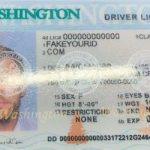In the digital – age of online transactions, the issue of fake IDs poses a significant threat to the security of online payment gateways. As we look towards 2025, the sophistication of fake identification documents and the increasing volume of online transactions make this a pressing concern for businesses, consumers, and financial institutions alike.
Understanding Fake IDs
Fake IDs are counterfeit or altered identification documents that are used to misrepresent a person’s identity. These can include fake driver’s licenses, passports, and other forms of identification. In the context of online payment gateways, fraudsters use fake IDs to open accounts, make transactions, and evade detection.
The production of fake IDs has become more advanced in recent years. With the availability of high – quality printing technology and access to personal information through data breaches, fraudsters are able to create IDs that are difficult to distinguish from genuine ones. They may also use techniques such as photo – shopping and laminating to make the fake IDs look more authentic.

The Impact on Online Payment Gateways
Online payment gateways are the intermediaries between merchants and customers, facilitating the transfer of funds during online transactions. When fake IDs are used in these transactions, it can lead to a number of security risks.
One of the main risks is account takeover. Fraudsters use fake IDs to create new accounts or gain access to existing ones. Once they have control of an account, they can make unauthorized transactions, such as purchasing goods and services or transferring funds to other accounts. This can result in financial losses for both the customer and the merchant.
Another risk is money laundering. Criminals may use fake IDs to set up accounts for the purpose of laundering money. They can deposit illegal funds into these accounts and then transfer them to legitimate – looking accounts, making it difficult for law enforcement agencies to trace the origin of the money. This not only undermines the integrity of the financial system but also poses a risk to the reputation of online payment gateways.

Fake IDs can also lead to chargebacks. When a customer disputes a transaction, claiming that it was unauthorized, the payment gateway may be required to reverse the transaction. If the transaction was made using a fake ID, it can be difficult to determine who is truly responsible for the chargeback, leading to financial losses for the merchant and potential legal issues for the payment gateway.
How Fraudsters Use Fake IDs in Online Transactions
Fraudsters employ various methods to use fake IDs in online transactions. One common method is to create a new account using a fake ID. They may use stolen personal information, such as names, addresses, and Social Security numbers, to create a profile that appears legitimate. They then link a payment method, such as a credit card or bank account, to the account and start making transactions.
Another method is to use a fake ID to bypass identity verification processes. Many online payment gateways have identity verification procedures in place, such as asking for a photo ID or a security code. Fraudsters may use a fake ID that closely resembles a genuine one to pass these checks. They may also use techniques such as social engineering to trick the payment gateway into accepting their identity.

In some cases, fraudsters may use a combination of fake IDs and other forms of fraud, such as phishing attacks. They may send phishing emails or messages to customers, pretending to be from a legitimate payment gateway. The emails may contain links to fake websites that look like the real payment gateway’s site. When customers enter their personal and payment information on these fake sites, the fraudsters can use the information along with a fake ID to make unauthorized transactions.
Detecting Fake IDs in Online Payment Transactions
Detecting fake IDs is crucial for maintaining the security of online payment gateways. There are several methods that can be used to identify fake identification documents.
One of the most common methods is document verification. Payment gateways can use optical character recognition (OCR) technology to scan and analyze the text on an ID. They can then compare the information on the ID with other databases, such as government – issued identity records, to check for discrepancies. Additionally, they can look for security features on the ID, such as holograms, watermarks, and microprinting, which are difficult to replicate on fake IDs.
Biometric authentication is another effective method for detecting fake IDs. Biometric features, such as fingerprints, facial recognition, and iris scans, are unique to each individual and are difficult to forge. Payment gateways can use biometric authentication to verify the identity of a customer during the transaction process. This can help to prevent fraudsters from using fake IDs to access accounts.
Behavioral analytics can also play a role in detecting fake IDs. Payment gateways can analyze the behavior of customers during online transactions, such as the location from which the transaction is made, the time of day, and the type of products or services being purchased. If the behavior is unusual or inconsistent with the customer’s normal patterns, it may be an indication of fraud. For example, if a customer who usually makes purchases from their home location suddenly makes a large – value transaction from a different country, it could be a sign that a fake ID is being used.
Preventing Fake ID – Related Fraud in Online Payment Gateways
Preventing fake ID – related fraud requires a multi – pronged approach. First and foremost, payment gateways need to have robust identity verification processes in place. This includes asking for multiple forms of identification, such as a photo ID and a proof of address, and verifying the information against reliable databases.
Payment gateways should also educate their customers about the risks of fake ID – related fraud and how to protect themselves. This can include providing information on how to recognize phishing emails and messages, how to keep personal information secure, and what to do if they suspect that their identity has been compromised.
Another important aspect of prevention is collaboration between payment gateways, merchants, and law enforcement agencies. Payment gateways can share information about suspected fraud cases with merchants and law enforcement, which can help to identify and apprehend fraudsters. Additionally, merchants can play a role in preventing fraud by implementing their own security measures, such as fraud screening tools and transaction monitoring systems.
Finally, payment gateways need to stay up – to – date with the latest technologies and techniques for detecting and preventing fake ID – related fraud. This may include investing in new identity verification technologies, such as blockchain – based identity solutions, which can provide a more secure and reliable way of verifying identities.
Common Problems and Solutions
- Problem: Difficulty in Document Verification
Some fake IDs are so well – made that it can be difficult for payment gateways to detect them using traditional document verification methods. The text on the ID may be difficult to read or the security features may be replicated well enough to pass initial inspection.
Solution: Payment gateways can invest in more advanced document verification technologies, such as 3D – imaging and multispectral analysis. These technologies can analyze the ID from multiple angles and wavelengths, making it easier to detect subtle differences between genuine and fake IDs. Additionally, they can cross – reference the information on the ID with multiple databases to increase the accuracy of verification.
- Problem: Social Engineering Attacks
Fraudsters often use social engineering techniques to trick payment gateways into accepting fake IDs. They may pose as legitimate customers and use persuasive tactics to convince the payment gateway to bypass identity verification procedures or to release funds.
Solution: Payment gateways need to train their customer service representatives to be aware of social engineering attacks. Representatives should be taught how to ask the right questions and to verify the identity of the person they are speaking to. Additionally, payment gateways can implement additional security measures, such as two – factor authentication, when dealing with customer service requests related to account access or transactions.
- Problem: Data Breaches Compromising Identity Verification
If a payment gateway or a related organization experiences a data breach, fraudsters may gain access to the personal information of customers. This can be used to create more convincing fake IDs and to bypass identity verification processes.
Solution: Payment gateways need to have strong data security measures in place, such as encryption, access controls, and regular security audits. They should also have a plan in place for responding to data breaches, including notifying affected customers and law enforcement agencies in a timely manner. Additionally, they can use identity – theft protection services to help customers monitor their credit and identity in case of a breach.
- Problem: Inconsistent Identity Verification Across Platforms
Customers may use multiple online payment platforms, and the identity verification processes may vary from one platform to another. This can create opportunities for fraudsters to use a fake ID on one platform that may not be detected due to less stringent verification requirements.
Solution: There should be more standardization in identity verification across online payment platforms. Industry associations and regulatory bodies can play a role in setting common standards for identity verification. Payment gateways can also share best practices and collaborate on developing more consistent verification processes.
- Problem: High Cost of Fraud Prevention
Implementing advanced fraud prevention measures, such as biometric authentication and advanced document verification technologies, can be costly for payment gateways. This may lead some gateways to cut corners on security, increasing the risk of fake ID – related fraud.
Solution: Payment gateways need to view fraud prevention as an investment rather than a cost. By preventing fraud, they can avoid financial losses, protect their reputation, and maintain the trust of their customers. Additionally, they can explore cost – effective solutions, such as open – source fraud prevention tools and partnerships with technology providers to share the cost of implementing advanced security measures.
Fake ID Pricing
unit price: $109
| Order Quantity | Price Per Card |
|---|---|
| 2-3 | $89 |
| 4-9 | $69 |
| 10+ | $66 |



